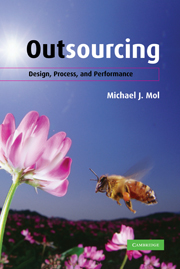Book contents
- Frontmatter
- Contents
- List of figures
- List of tables
- List of boxes
- Acknowledgments
- 1 Outsourcing
- 2 What we know about outsourcing
- 3 A new perspective
- 4 The outsourcing process
- 5 Shifting the curve
- 6 Shifts of the curve
- 7 Managing outsourcing
- 8 Outsourcing research agenda
- 9 Future trends and conclusions
- Appendix
- References
- Index
9 - Future trends and conclusions
Published online by Cambridge University Press: 03 February 2010
- Frontmatter
- Contents
- List of figures
- List of tables
- List of boxes
- Acknowledgments
- 1 Outsourcing
- 2 What we know about outsourcing
- 3 A new perspective
- 4 The outsourcing process
- 5 Shifting the curve
- 6 Shifts of the curve
- 7 Managing outsourcing
- 8 Outsourcing research agenda
- 9 Future trends and conclusions
- Appendix
- References
- Index
Summary
One of the observations with which this book started was that outsourcing is by no means a new phenomenon. Rather, it was argued that outsourcing is almost “as old as the hills.” Several older examples of outsourcing were also discussed. Outsourcing is an inherent feature of the way we organize ourselves. The question whether we will continue to see outsourcing is, therefore, a nonsensical one. There has been, is, and will continue to be outsourcing as long as firms and markets are around, regardless of whether markets are islands in a sea of firms (Simon, 1991) or firms are the anomaly to be explained (Coase, 1937; Williamson, 1975). Outsourcing, in many ways, is an artifact of the economy at large, and certainly of any economy that progresses beyond the hunter-gatherer stage.
But this does not imply there is anything like an actual or optimal outsourcing level that is stable across time or space. Nor does it mean that managerial mindsets on outsourcing are an idée fixe or that it is inevitable that we should see more outsourcing processes than insourcing processes in the future. If anything, we ought to believe that we do not know and cannot predict what will happen to each of these variables. Yet it is possible to outline some of the causes of trend shifts and therefore to come up with a few “what if” scenarios.
- Type
- Chapter
- Information
- OutsourcingDesign, Process and Performance, pp. 184 - 189Publisher: Cambridge University PressPrint publication year: 2007



